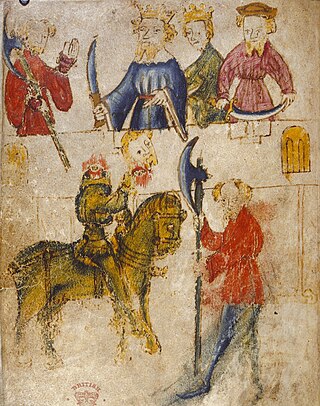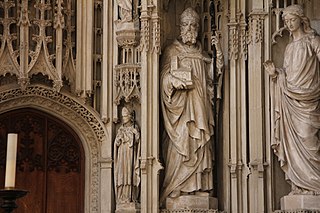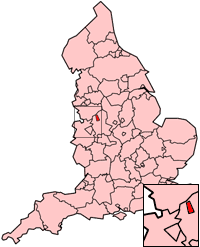
Sir Gawain and the Green Knight is a late 14th-century chivalric romance in Middle English. The author is unknown; the title was given centuries later. It is one of the best-known Arthurian stories, with its plot combining two types of folk motifs: the beheading game, and the exchange of winnings. Written in stanzas of alliterative verse, each of which ends in a rhyming bob and wheel; it draws on Welsh, Irish, and English stories, as well as the French chivalric tradition. It is an important example of a chivalric romance, which typically involves a hero who goes on a quest which tests his prowess. It remains popular in modern English renderings from J. R. R. Tolkien, Simon Armitage, and others, as well as through film and stage adaptations.
Patience is a Middle English alliterative poem written in the late 14th century. Its unknown author, designated the "Pearl Poet" or "Gawain-Poet", also appears, on the basis of dialect and stylistic evidence, to be the author of Sir Gawain and the Green Knight, Pearl, and Cleanness and may have composed St. Erkenwald. This is thought to be true because the techniques and vocabulary of regional dialect of the unknown author is that of Northwest Midlands, located between Shropshire and Lancashire.

The "Gawain Poet", or less commonly the "Pearl Poet", is the name given to the author of Sir Gawain and the Green Knight, an alliterative poem written in 14th-century Middle English. Its author appears also to have written the poems Pearl, Patience, and Cleanness; some scholars suggest the author may also have composed Saint Erkenwald. Save for the last, all these works are known from a single surviving manuscript, the British Library holding 'Cotton MS' Nero A.x. MS Nero A X. This body of work includes some of the most highly-regarded poetry written in Middle English.

Pearl is a late 14th-century Middle English poem that is considered one of the most important surviving Middle English works. With elements of medieval allegory and from the dream vision genre, the poem is written in a North-West Midlands variety of Middle English and is highly—though not consistently—alliterative; there is, among other stylistic features, a complex system of stanza-linking.

The Green Knight is a heroic character of Arthurian legend, originating in the 14th-century poem Sir Gawain and the Green Knight and the related medieval work The Greene Knight. His true name is revealed to be Bertilak de Hautdesert in Sir Gawain, while The Greene Knight names him "Bredbeddle". The Green Knight later features as one of Arthur's greatest champions in the fragmentary ballad "King Arthur and King Cornwall", again with the name "Bredbeddle".

St Erkenwald is a fourteenth-century alliterative poem in Middle English, perhaps composed in the late 1380s or early 1390s. It has sometimes been attributed, owing to the Cheshire/Shropshire/Stafffordshire Dialect in which it is written, to the Pearl poet who probably wrote the poems Pearl, Patience, Cleanness, and Sir Gawain and the Green Knight.

Saint Earconwald or Erkenwald was a Saxon prince and Bishop of London between 675 and 693. He is the eponymous subject of one of the most important poems in the foundations of English literature. He was called Lundoniae maximum sanctus, 'the most holy figure of London', and Lux Londonie, "the light of London". Peter Ackroyd has said of him, "we may still name him as the patron saint of London, [his]... cult survived for over eight hundred years, before entering the temporary darkness of the last four centuries".
Huchoun, Huchown or Huchowne "of the Awle Ryale" is a poet conjectured to have been writing sometime in the 14th century. Some academics, following the Scottish antiquarian George Neilson (1858–1923), have identified him with a Scottish knight, Hugh of Eglinton, and advanced his authorship of several significant pieces of alliterative verse. Current opinion is that there is little evidence to support this.
Layamon's Brut, also known as The Chronicle of Britain, is a Middle English poem compiled and recast by the English priest Layamon. Layamon's Brut is 16,096 lines long and narrates the history of Britain up to the Early Middle Ages. It is the first work of history written in English since the Anglo-Saxon Chronicle. Named for Britain's mythical founder, Brutus of Troy, the poem is largely based on the Anglo-Norman French Roman de Brut by Wace, which is in turn a version of Geoffrey of Monmouth's Latin Historia Regum Britanniae. Layamon's poem, however, is longer than both and includes an enlarged section on the life and exploits of King Arthur. It is written in the alliterative verse style commonly used in Middle English poetry by rhyming chroniclers, the two halves of the alliterative lines being often linked by rhyme as well as by alliteration.

Potteries is an English dialect of the West Midlands of England, almost exclusively in and around Stoke-on-Trent, Staffordshire.
The Alliterative Morte Arthure is a 4346-line Middle English alliterative poem, retelling the latter part of the legend of King Arthur. Dating from about 1400, it is preserved in a single copy in the 15th-century Lincoln Thornton Manuscript, now in Lincoln Cathedral Library.

The Cheshire dialect is a Northern English dialect spoken in the county of Cheshire in North West England. It has similarities with the dialects of the surrounding counties of Merseyside, Greater Manchester, Staffordshire, Shropshire, and Derbyshire.
Ronald Alan Waldron is an English medievalist, considered a pre-eminent expert in the field of early English literature. He wrote many books and was a lecturer at the University of Aarhus in Denmark and King's College London. He made an especial focus on the poem Sir Gawain and the Green Knight.
Wynnere and Wastoure is a fragmentary Middle English poem written in alliterative verse around the middle of the 14th century.
The Awntyrs off Arthure at the Terne Wathelyne is an Arthurian romance of 702 lines written in Middle English alliterative verse. Despite its title, it centres on the deeds of Sir Gawain. The poem, thought to have been composed in Cumberland in the late 14th or early 15th century, survives in four different manuscripts from widely separated areas of England.
The Alliterative Revival is a term adopted by literary historians to refer to the resurgence of poetry using the alliterative verse form in Middle English between c. 1350 and 1500. Alliterative verse was the traditional verse form of Old English poetry; the last known alliterative poem prior to the Revival was Layamon's Brut, which dates from around 1190.
The Knightly Tale of Gologras and Gawain is a Middle Scots Arthurian romance written in alliterative verse of 1362 lines, known solely from a printed edition of 1508 in the possession of the National Library of Scotland. No manuscript copy of this lively and exciting tale has survived.

John Massey is one conjectured name of the Gawain Poet, author of Sir Gawain and the Green Knight and probably of several other 14th-century Middle English poems. Internal evidence from the text of the poems and marginalia of the manuscript suggests the name "John Massey" or similar; contemporary records of people of the name who might have been poets include one from the village of Cotton in Cheshire.
Thorlac Francis Samuel Turville-Petre is an English philologist who is Professor Emeritus and former head of the School of English at the University of Nottingham. He specializes in the study of Middle English literature.

The Pearl Manuscript, also known as the Gawain manuscript, is an illuminated manuscript produced somewhere in northern England in the late 14th century or the beginning of the 15th century. It is one of the best-known Middle English manuscripts, the only one containing alliterative verse solely, and the oldest surviving English manuscript to have full-page illustrations. It contains the only surviving copies of four of the masterpieces of medieval English literature: Sir Gawain and the Green Knight, Pearl, Cleanness, and Patience. It has been described as "one of the greatest manuscript treasures for medieval literature", and "the most famous of all romance manuscripts".








